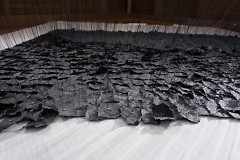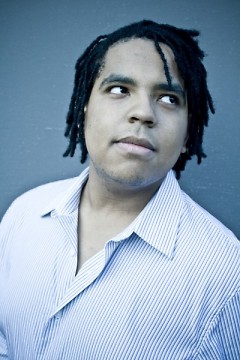“I was boiling lye in the kitchen, and my mom freaked out. I had to use drain opener, since it’s 100% lye. I had gloves and a respirator on, boiling this big pile of death. And I don’t know if I had the wrong chemicals or if it boiled too long, but nothing happened with the paper. It just stayed as squares of cotton. It was a huge letdown after I basically made fumes of death in my kitchen and nothing happened,” says Andrew Hawkes, ArtPrize artist at the Grand Rapids Art Museum (GRAM), about the ins and outs of making paper at home.
Such is an artist’s devotion that Hawkes shears apart old t-shirts and risks his own safety, turning his family kitchen into a toxic laboratory, all for the sake of illumination. “The pictures I took were interesting,” he concedes.
The messiness has done little to sway his interest. While Hawkes could have turned to his first passion for photography for a career, he has instead fixed his attention on a much older medium: paper. It’s this dogged dedication to his craft that has led to Hawkes being one of a number of other mixed-media artists exhibiting their work as part of Transformation at the Grand Rapids Art Museum during this year’s ArtPrize.
Art wasn’t Hawkes’ first choice. The 24-year old from Warren, Michigan recalls a general interest and trips to the Detroit Institute of Arts as a child, but it wasn’t until his senior year of high school that he joined the photo club and began to exercise his creative muscles. He decided “I like this. I’m going to try going to college for art.”
Having little experience, he refrained from taking chances on large, well known programs, instead applying to Central Michigan University (CMU), where he wouldn’t be pressured to declare a major until his junior year. That move proved to be perfect. He was provided mentoring, resources and freedom to explore his options, which in fact led him to drop photography in favor of printmaking.
“Being a photographer, it was so clean. It was so sterile being on a computer. I wanted to get messy,” he says. “There’s something ominous about paper. It’s indicative of something.” A deeper appreciation of paper wasn’t his only discovery however. While he followed his calling at CMU he also learned the full extent of the anxiety that plagued him his entire life.
“I don’t think I’ll ever not be an anxious person,” says Hawkes, who sought an explanation for increasingly frequent panic attacks close to graduation. He was diagnosed with generalized anxiety, which actually came as more of a relief than a sentence.
“I had panic attacks, and I finally knew they were panic attacks. When I realized that, I could talk myself down… it was empowering to understand these undercurrents of my life: why I couldn’t sleep, how I interacted with others,” he says.
Hawkes’ anxiety and obsessive tendencies are evident in his artwork. He laughs, calling himself pessimistic for not seeing a future free from anxiety, but his art has given those impulses an outlet.
“It helps me find something beautiful, instead of being a tightly wound person," he says. "There’s something beautiful about making something about being depressed…this art developed from this anxiety, as I understood I had it.”
Obsession is certainly channeled into his piece, "its not my fault," on display at the GRAM. His meticulousness is marked by 1,346 strings nailed to 1,346 handmade, black-dyed paper squares. “I had a system to make sure no paper didn’t have a nail in it. It’d seem dishonest if every paper didn’t have a nail,” says Hawkes. “Pretty much all of my free time was spent making the paper.” The piece’s composition – a sagging sideways pyramid of thin black strings that originates from the seat of a plain black chair and bows toward a wall filled with pitch black paper scraps – gives the impression of a mind beset by countless troubles.
He comes closest to an operative mission statement when he says “I make art about myself, but not for myself.”
“Good art starts a conversation. It makes someone think. Maybe they don’t consider the piece of art, but they think,” says Hawkes.
His hopes are that his work is embraced universally, even if it is deeply personal.
“That was my goal," he explains. "If someone didn’t read my statement or know me, they’d still take something away, either from the aesthetic experience... or think about their own lives.”
It’s a big step in a budding career and a huge honor for Hawkes to see his work standing placard to placard with the work of esteemed artists from around the world, most notably Kumi Yamashita.
“I’d never get to show with her. She’s an established artist and I’m not. Suddenly I’m in a group show with her and having coffee with her,” says Hawkes, describing the opportunities opened up by ArtPrize. “I’m exhibiting with her and I’m in the same circle, and I feel like I’m next to them. You’d think of these artists as rock stars.”
He chides himself for reusing words. Surreal. Weird. Given his constant beaming smile, the slight lapses in articulation are perpetrated with the highest regard for the ArtPrize model. And considering he’s a recent college grad, Hawkes is allowed the leeway to process the progress he’s made since school. ArtPrize has done much to dispel his fears about living beyond the relative security of academia.
“As an artist, you’re very much alone. You talk to other artists, but in general there’s not a lot of interest. Coming here, the city is hungry for art. It doesn’t matter who wins or places, it’s so interesting to see the excitement about people making art. I was so inspired to continue to make art, because it matters and people care. People love art, no matter how much you feel like they don’t,” he says.
ArtPrize isn’t the only thing that has Hawkes excited. His booking at the GRAM left him “really, really confused and excited… I didn’t think any gallery would want me. I have a big installation that will destroy a wall. I’d only been in mid-Michigan; I’d been out of school for a month and I was so full of doubt," admits Hawkes. "It was hugely validating to have someone say ‘Hey, what you’re doing is worthwhile. You’re doing okay. You’re doing good.’ I didn’t believe it at first.”
Hawkes certainly has transformed ordinary paper into something extraordinary. “We encounter paper every day of our lives… I never considered it as something special, as a form of technology,” he says about his discovery of the medium. Surely though, anyone who encounters his paper creations at this year’s ArtPrize will consider it something beyond special.
Andrew Hawkes’s piece "its not my fault" is on display at the Grand Rapids Art Museum as part of its Transformation experience, featuring over 20 pieces of work from separate artists. More of Hawkes’s works are available to view on his website.
The Rapidian, a program of the 501(c)3 nonprofit Community Media Center, relies on the community’s support to help cover the cost of training reporters and publishing content.
We need your help.
If each of our readers and content creators who values this community platform help support its creation and maintenance, The Rapidian can continue to educate and facilitate a conversation around issues for years to come.
Please support The Rapidian and make a contribution today.


